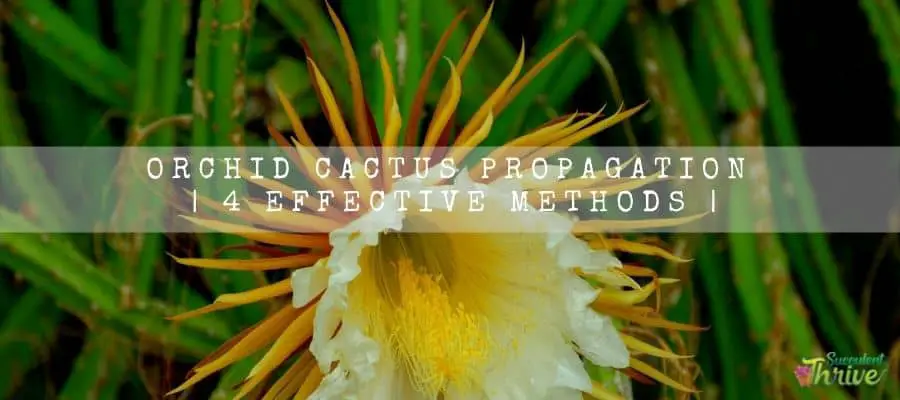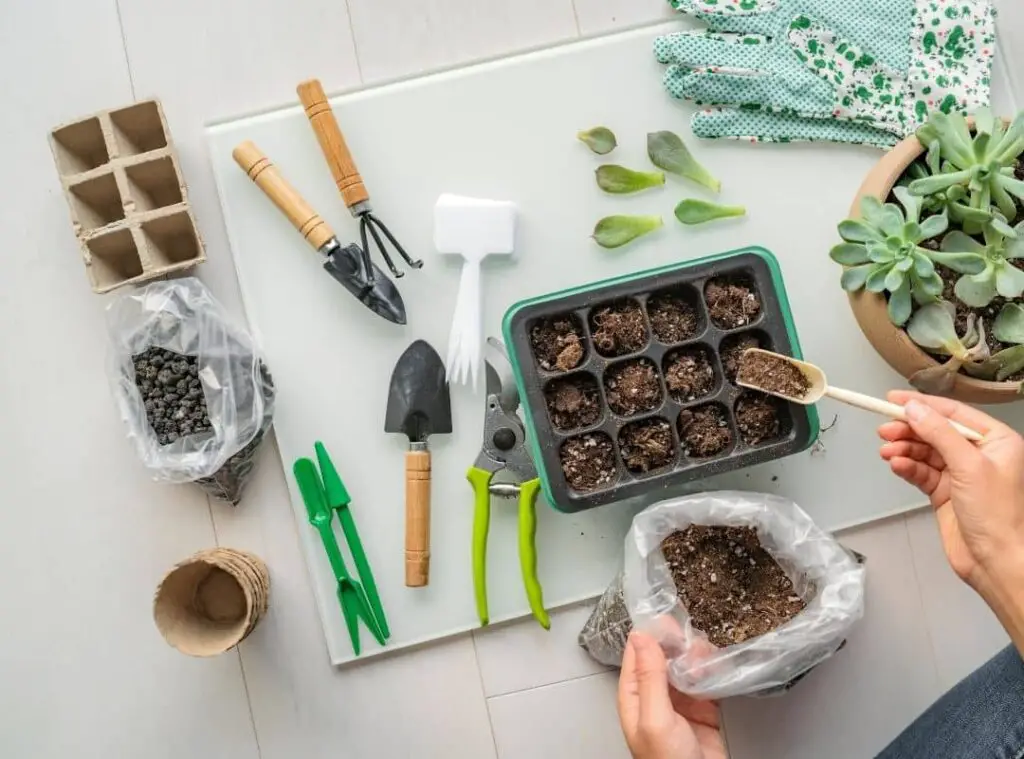You can conduct orchid cactus propagation by leaves and stem cuttings. Other than that you can use seeds and offset to propagate orchid cactus. Find out about all 4 orchid cactus propagation methods in this article.

What is orchid cactus?
If you were looking to add a plant which has a pleasant fragrance and bright color formation, Orchid cactus would be ideal to have.
Orchid cactus go by the common names queen of the night, leaf cactus, Dutchman’s pipe cactus etc.
They are becoming more trendy among the succulent enthusiasts. Orchid cactus’s flower blossoming in spring would be an added advantage of having them in your indoor garden collection.
To briefly elaborate on the plant’s appearance, they have segmented, serrated stems and that characteristic makes them perfect picks for hanging pots.
They are epiphytes which literally means they grow on some other plant’s surface in their natural habitat.
This article is about how to propagate them properly and how you should look after them after you propagate them
Orchid Cactus Propagation by stem Cuttings
Using the stem cuttings is the easiest way of propagating the Orchid cactus. When you get the cuttings, make sure that you are getting them from healthy plants.
You need to simply trim off a stem from the plants and leave them in a warmer place where they can wither and develop callous. You need to allow them to develop calluses for about one week’s time.
When you use callused cuttings for propagation, it will ensure that there will be no infections occur during the propagation process.
Next, place the cuttings in a clean and pre moistened soil mix which has an excellent draining. Make sure that there are only two leaf serrations under the soil.
Next, leave them in a spot where they can absorb bright indirect sunlight. Mist them on a regular basis and you will see how they form roots within three weeks to six weeks’ time.
Orchid Cactus Propagation by by leaf Cuttings.
Using the leaf cuttings to propagate them is also easy and you could see faster results of that too.
All you need to do is to cut a leaf which is about 4 inches ( 10 cm) in size and allow them to wither for a few days.
Next you could place it in the soil upside down in a depth of about 1-2 inches.It will make the leaf cuttings stable in the pot.
Suspend watering them for a few days so that it would not create any infections. The leaf cuttings will start to develop roots after some time.
Do they produce seeds?
Orchid cactus produces seeds. In fact, the flowers of the Orchid cactus would transform into a fruit and it has small seeds included.
If you are a patient succulent gardener, you could use their seeds to propagate them. To be precise it will take about five years’ time to have a proper plant from seeds.
Do they produce offsets
Orchid cactus produce offsets. However you will have to await a long time until they produce offsets though.

How to treat after propagation
Light requirement of Orchid cactus.
Bright indirect sunlight would be helpful for the optimal growth of the Orchid cactus. They need to have strong sunlight to perform well.
They are tolerant of more sunlight compared to moth orchids. Hence a brightly lit place such as bright sunny windowsill would be ideal for them.
Alternatively, you can place them outdoors if there are favorable weather conditions.
If your Orchid cactus are running short of sunlight or receiving excessive sunlight levels, you could identify that by the signs they send out.
For example, If the plants are getting too much sunlight, their leaves would turn pale yellow in color. Finally, they will start to wilt.
Temperature requirement of Orchid cactus.
Orchid cactus prefer to have a cooler climate. Hence, they would be great picks as great houseplants.
A temperature range around 65-75 degrees Fahrenheit / 18-24 degrees Celsius would work well with these plants.
Besides, they are tolerant of fluctuating temperature ranges as well. Hence you can place them near the windowsill as the temperature around the windowsill would be cooler during nighttime.
Having said that, ensure that you do not leave them for temperatures below 50 degrees Fahrenheit ( 10 degrees Celsius) as that would be the maximum temperature they can survive.
When they grow in their natural habitat, their temperature does not ever drop below 50 degrees Fahrenheit.
Humidity requirement of Orchid cactus
Orchid cactus needs high humidity levels to thrive well and that is the only issue you will have when you grow them indoors. Ideally a humidity level which is above 55 % would perfectly fit in for them.
Water requirement of Orchid cactus
Despite the name they have, Orchid cactus prefer to have moderate water levels. They do not like to be done dry and do not prefer to be over-watered also.
Watering the Orchid cactus properly is the most crucial factor when looking after the plants. You need to be smart enough to water them properly without letting them dry or without over watering them too.
You need to ensure that the plant’s roots become dry between two watering sessions. Ensure that you are keeping the soil moist spring to fall which is when the plants are actively growing well.
You may minimize watering them in winter and water them less often. However, ensure that you do not let them develop shriveled or limp stems as those are indications of under watering.
Soil requirement of Orchid cactus.
Best is to grow them in an orchid potting soil mix as they are well draining.
If you wish to make a potting medium on your own, you could add 1 part of an organic potting mix such as perlite, pebbles or bark into 3 parts of potting soil. You may consider adding moss or sand also as they wish to be a little moist.
Fertilizer requirements of orchid cacti
You may consider adding a 10-10-10 fertilizer fortnightly. Refrain from using fertilizers which have a bigger amount of Nitrogen as they could be harmful. Refrain from feeding them during winter as it will be dormancy.
Related questions
How do you root the orchid cactus cuttings?
Briefly, you simply have to obtain healthy looking cuttings and grow them in a well draining soil mix.
How do you separate the orchid cactus pups?
Remove the orchid cactus and get rid of the older soil around the roots. Chances are that the larger plants may consist of several cuttings. Hence you need to separate the roots carefully.
Besides, you can separate a large orchid cactus by cutting it into parts while using sterilized gardening shears. Ensure that you allow the cut parts to develop callous and then transplant them.
Does an orchid cactus need sunlight?
Orchid cactus require bright indirect sunlight right throughout the year. If you grow them outdoors during summer, grow them in a semi shady place.
Conclusion
Orchid cactus is such a cute and attractive set of plants which will add so much glamor and fragrance to wherever you locate them.
They would look amazing when you grow them in hanging baskets. Propagating the orchid cactus is easy and looking after them is also a simple process.
If you manage to water them properly , whilst growing them in a well-draining soil and exposing them to the right temperature, light and humidity levels, they will grow to their fullest potential . They will survive for a number of years as well.
Read Next : Ferocactus Pilosus Propagation ( The Only Method You Need ) Chandelier Plant Propagation | 4 Effective Methods | String Of Buttons Propagation | 5 Effective Propagation Methods |
